Contents

Weather in September
Temperature
September denotes a minimal variation in the average high-temperature to a still hot 30°C (86°F) from August's 30.2°C (86.4°F). Male's September nights exhibit a subtle drop in temperature, averaging at a warm 25.1°C (77.2°F), closely aligned with the daytime highs.Heat index
In September, the heat index is calculated to be a sweltering 38°C (100.4°F). Incorporate special precautions, risk of heat exhaustion and heat cramps is substantial. Sustained activity could cause heatstroke.When assessing, remember that heat index measurements are for light winds and shaded spots. Uninterrupted exposure to the sun may boost the heat index values by 15 Fahrenheit (8 Celsius) degrees.
Note: The heat index, also known as 'real feel' or 'apparent temperature', is an indicator that blends the effects of temperature and humidity to depict perceived warmth. Elements such as metabolic variations, pregnancy, and physical exertion can shape one's weather perception. Under direct sun rays, the felt temperature might be heightened, with the heat index increasing by 15 Fahrenheit (8 Celsius) degrees. Heat index values are particularly relevant to babies and toddlers. In general, younger individuals are at greater risk than adults because they tend to sweat less. Also, having a larger skin surface to body size ratio and greater heat production due to their active behavior contribute to this danger.
The innate cooling system of the human body revolves around perspiration, with the evaporation of sweat being central to this process. With a high level of moisture in the air, the evaporation process becomes less efficient, preventing the body from cooling down efficiently and resulting in a sensation of overheating. If heat absorption exceeds the body's cooling ability, body temperature can elevate, resulting in potential thermal illnesses.
Humidity
The average relative humidity in September is 81%.Rainfall
The month with the most rainfall is September, when the rain falls for 15.8 days and typically aggregates up to 243mm (9.57") of precipitation.Sea temperature
In September, the average sea temperature is 28.9°C (84°F).Note: For engaging in any water activities, temperatures from 25°C (77°F) to 29°C (84.2°F) are viewed as outstanding and exceptionally pleasing for prolonged durations.
Daylight
In Male, the average length of the day in September is 12h and 8min.On the first day of September, sunrise is at 06:00 and sunset at 18:11. On the last day of the month, sunrise is at 05:53 and sunset at 17:58 +05.
Sunshine
June and September, with an average of 6.7h of sunshine, are months with the least sunshine.UV index
The months with the highest UV index are January through May, August through November, with an average maximum UV index of 12. A UV Index estimate of 11, and higher, represents an extreme threat to health from unsafe exposure to UV radiation for the average person.Note: The maximum daily UV index of 12 during September translates into the following directions:
Utilize every vital safety procedure. Individuals with light skin may endure burns in less than 5 minutes. Seek shade and limit direct sun exposure between 10 a.m. and 4 p.m., the peak period for UV radiation. Keep in mind that shade structures like parasols or canopies do not offer complete sun protection. It's wise to wear UVA and UVB-blocking sunglasses when the sun shines brightly. Apply generously and frequently reapply a sunscreen with SPF 30 or more even on cloudy days, particularly after a swim or outdoor exercise. Take note! Sand and water reflections strengthen the Sun's UV exposure.
Published by: Weather Atlas | About Us
Data Sources | Weather Forecasting & Climate
Frequently asked questions
Is it hot during September?
What is the average humidity in September?
What is the wettest month?
How many days does it rain in September?
What is the sea water temperature in September?
What is the average length of the day in September?
What time are sunrise and sunset in September in Male?
What are the months with the least sunshine?
How many hours of sunshine does Male have in September?
When is the highest UV index?
What is the UV index intensity in September?
Average temperature in September
Male, Maldives
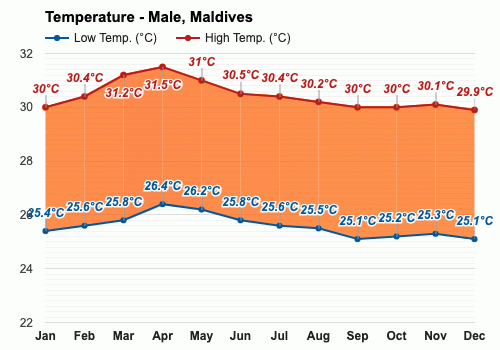
- Average high temperature in September: 30°C
The warmest month (with the highest average high temperature) is April (31.5°C).
The month with the lowest average high temperature is December (29.9°C).
- Average low temperature in September: 25.1°C
The month with the highest average low temperature is April (26.4°C).
The coldest months (with the lowest average low temperature) are September and December (25.1°C).
Average humidity in September
Male, Maldives
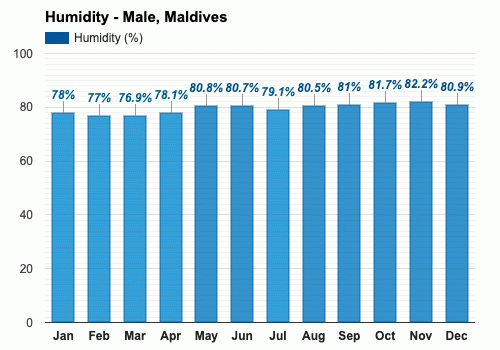
- Average humidity in September: 81%
The month with the highest relative humidity is November (82.2%).
The month with the lowest relative humidity is March (76.9%).
Average rainfall in September
Male, Maldives
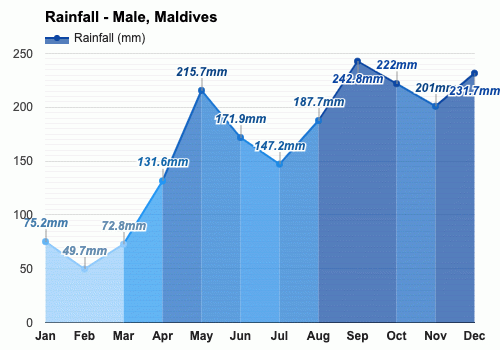
- Average rainfall in September: 242.8mm
The wettest month (with the highest rainfall) is September (242.8mm).
The driest month (with the least rainfall) is February (49.7mm).
Average rainfall days in September
Male, Maldives
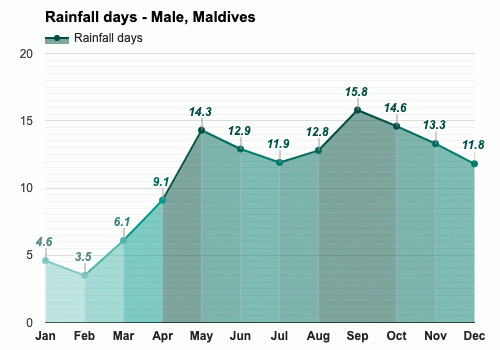
- Average rainfall days in September: 15.8 days
The month with the highest number of rainy days is September (15.8 days).
The month with the least rainy days is February (3.5 days).
Average sea temperature in September
Male, Maldives
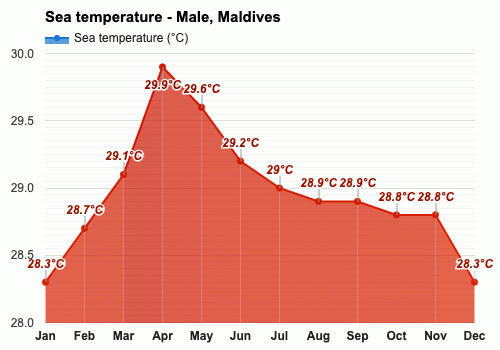
- Average sea temperature in September: 28.9°C
The best month for swimming (with the highest average sea temperature) is April (29.9°C).
The coldest months (with the lowest average sea temperature) are January and December (28.3°C).
Average daylight in September /
Average sunshine in September
Male, Maldives

- Average daylight in September: 12h and 1min
The month with the longest days is June (Average daylight: 12h and 24min).
The month with the shortest days is December (Average daylight: 11h and 54min).
- Average sunshine in September: 6h and 4min
The month with the most sunshine is February (Average sunshine: 9h and 18min).
The months with the least sunshine are June and September (Average sunshine: 6h and 42min).
Average UV index in September
Male, Maldives

- Average UV index in September: 12
The months with the highest UV index are January, February, March, April, May, August, September, October and November (UV index 12).
The months with the lowest UV index are June, July and December (UV index 11).
Male, Maldives
Weather forecast for your location
2. Allow the app to use your location


